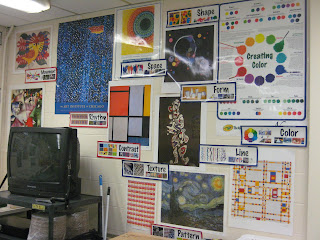Let’s pretend you’re new to a school district, and you discover that your limited on your resources. The cart has little space, there’s no storage, and materials are all over the place. If you’re on a cart or travel, this is a very familiar situation to you, and you still juggle what space you have. Besides screaming (which sometimes seems like the only option when your frustrated), explore your options.
Your Ideal Cart
When I began traveling, I set myself up on two different carts at two different schools. Why? They were the only options I had at the time. Over the next year, I found which cart was best for my situation, and which one I wanted to kick over.
I find that creating organized space helped my sanity. For example…if you have a cart that can hold bins, fill some of the bins with items you use almost every class period, such as glue, scissors, assessment sheets, and other items you see fit. With the materials always in the same place, I can send my student to the cart and they know exactly where the item is they’re looking for.
(Psst...this one's my favorite!)
Leave additional space for temporary materials, such as specific lesson items, games (for students who finish early), and others items needed for the day. I always leave two empty bins on my cart for this exact reason, and I can fill/refill when I walk by my storage closet.
Squeeze in that space for student resources, such as drawing books, art books, and art games. Again, the students will know where it is, and where to place the items during clean up.
Create a display space on your cart. Sometimes I walk into a room and discover the homeroom teacher has used all the chalkboard space, so I must find my own. This is a slight irritation at first (which is understandable), but being prepared is always helpful. If you have no way of creating space on your cart, this is where that communication word comes in handy. Discuss with the homeroom teacher about leaving additional space on the board. On an additional note…buy your own magnets and label them! Magnets are one item I treasure, and lose at the same time. I’ve been lucky with students that are helpful and return forgotten magnets before I leave for the day.
Create a separate cubby for your personal items, such as your own pair of scissors, glue, and other materials you want for your own use. I have a cart where I can keep materials up high in a separate basket (there will always be that child that wants to use the teacher’s materials).
And lastly, for that cart that is bugging you to no end, here’s a suggestion. Look at your supply budget and see if you can squeeze in a spare 250.00 for a new cart that hold all this wonderful storage I discussed in the previous paragraphs. It was the best investment I made at my second cart school! I now use that old, immobile metal cart as a storage cart, which holds a drying rack and resources for students who finish work early. Best thing I ever did.
Your Storage and Space
Is your storage area a closet? Are you left with a small drying rack and no space for other classes? Do you also share your space with other art teachers? I sympathize, and I can also offer advice for your lack of space.
One of the schools I teach is shared with another art teacher. Some classes are mine, the rest of the school is the second art teacher. We get along very well because we communicate about the shared items, such as drying racks, projectors, and painting carts. We decided to keep our consumable materials in our own space, which has made it very easy to know what we have for our own classes, without worry about missing items. We also designated specific display areas around the school, which prevents miscommunication with showing off finished products from other classes.
When the drying rack is overfilled and overstuffed, I communicate with the homeroom teachers about temporarily leaving materials to dry in a corner table or window area for about an hour. This is a good amount of time for drying and makes it easy to stack projects by the end of the day.
Sculpture materials are fun to make, but a pain to store when you’re gone. My teachers are very nice and allow me to store a plastic bin on top of their storage closets, which keep the students from tampering with them during the week. This method has helped me, the teacher, and the students since my first year teaching, and allows me to continue creating the messy, stinky clay projects everyone loves.
Display space is always an issue because I am not at the school every day of the week. If I know I want to display a student project in advance, I will ask the administrator for permission to use a specific space within a time frame, and I’ve always been granted the space. Go ahead, try it and you’ll get great results and a group of kids who are proud of their work!
Don’t have space to display 3D materials? I don’t either. I discovered photos of the students with their projects are wonderful and much easier to hang up and take down. Plus, the students gets to keep their picture!
Lack of space can be extremely frustrating. With a little organization communication, and flexibility, your troubles can flip to resolutions. I’ve been there, and I still hit snags, but we deal and push on to find ways to adapt.







